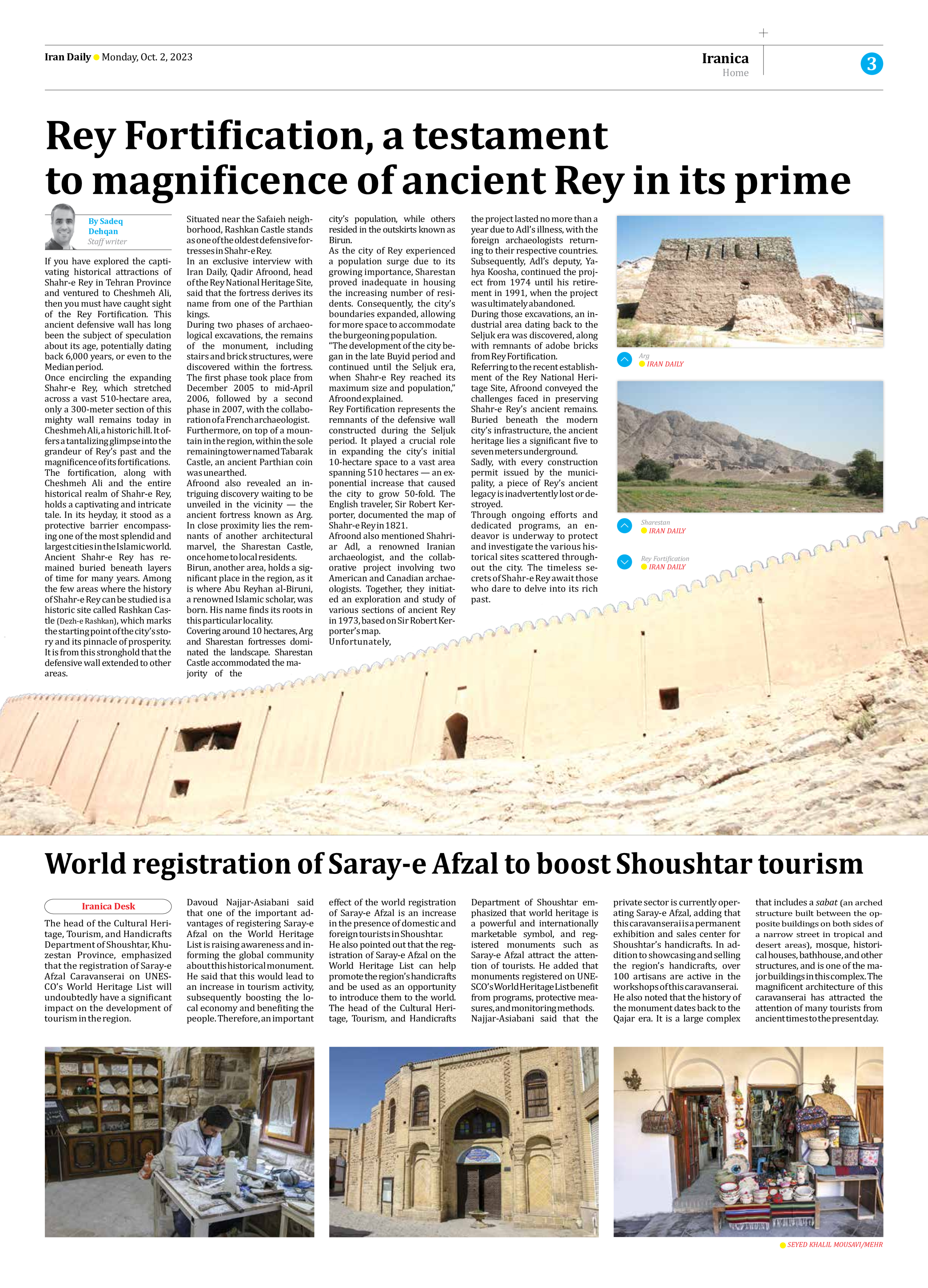
Rey Fortification, a testament to magnificence of ancient Rey in its prime
By Sadeq Dehqan
Staff writer
If you have explored the captivating historical attractions of Shahr-e Rey in Tehran Province and ventured to Cheshmeh Ali, then you must have caught sight of the Rey Fortification. This ancient defensive wall has long been the subject of speculation about its age, potentially dating back 6,000 years, or even to the Median period.
Once encircling the expanding Shahr-e Rey, which stretched across a vast 510-hectare area, only a 300-meter section of this mighty wall remains today in Cheshmeh Ali, a historic hill. It offers a tantalizing glimpse into the grandeur of Rey’s past and the magnificence of its fortifications.
The fortification, along with Cheshmeh Ali and the entire historical realm of Shahr-e Rey, holds a captivating and intricate tale. In its heyday, it stood as a protective barrier encompassing one of the most splendid and largest cities in the Islamic world.
Ancient Shahr-e Rey has remained buried beneath layers of time for many years. Among the few areas where the history of Shahr-e Rey can be studied is a historic site called Rashkan Castle (Dezh-e Rashkan), which marks the starting point of the city’s story and its pinnacle of prosperity. It is from this stronghold that the defensive wall extended to other areas.
Situated near the Safaieh neighborhood, Rashkan Castle stands as one of the oldest defensive fortresses in Shahr-e Rey.
In an exclusive interview with Iran Daily, Qadir Afroond, head of the Rey National Heritage Site, said that the fortress derives its name from one of the Parthian kings.
During two phases of archaeological excavations, the remains of the monument, including stairs and brick structures, were discovered within the fortress. The first phase took place from December 2005 to mid-April 2006, followed by a second phase in 2007, with the collaboration of a French archaeologist.
Furthermore, on top of a mountain in the region, within the sole remaining tower named Tabarak Castle, an ancient Parthian coin was unearthed.
Afroond also revealed an intriguing discovery waiting to be unveiled in the vicinity — the ancient fortress known as Arg. In close proximity lies the remnants of another architectural marvel, the Sharestan Castle, once home to local residents.
Birun, another area, holds a significant place in the region, as it is where Abu Reyhan al-Biruni, a renowned Islamic scholar, was born. His name finds its roots in this particular locality.
Covering around 10 hectares, Arg and Sharestan fortresses dominated the landscape. Sharestan Castle accommodated the majority of the city’s population, while others resided in the outskirts known as Birun.
As the city of Rey experienced a population surge due to its growing importance, Sharestan proved inadequate in housing the increasing number of residents. Consequently, the city’s boundaries expanded, allowing for more space to accommodate the burgeoning population.
“The development of the city began in the late Buyid period and continued until the Seljuk era, when Shahr-e Rey reached its maximum size and population,” Afroond explained.
Rey Fortification represents the remnants of the defensive wall constructed during the Seljuk period. It played a crucial role in expanding the city’s initial 10-hectare space to a vast area spanning 510 hectares — an exponential increase that caused the city to grow 50-fold. The English traveler, Sir Robert Kerporter, documented the map of Shahr-e Rey in 1821.
Afroond also mentioned Shahriar Adl, a renowned Iranian archaeologist, and the collaborative project involving two American and Canadian archaeologists. Together, they initiated an exploration and study of various sections of ancient Rey in 1973, based on Sir Robert Kerporter’s map.
Unfortunately, the project lasted no more than a year due to Adl’s illness, with the foreign archaeologists returning to their respective countries. Subsequently, Adl’s deputy, Yahya Koosha, continued the project from 1974 until his retirement in 1991, when the project was ultimately abandoned.
During those excavations, an industrial area dating back to the Seljuk era was discovered, along with remnants of adobe bricks from Rey Fortification.
Referring to the recent establishment of the Rey National Heritage Site, Afroond conveyed the challenges faced in preserving Shahr-e Rey’s ancient remains. Buried beneath the modern city’s infrastructure, the ancient heritage lies a significant five to seven meters underground.
Sadly, with every construction permit issued by the municipality, a piece of Rey’s ancient legacy is inadvertently lost or destroyed.
Through ongoing efforts and dedicated programs, an endeavor is underway to protect and investigate the various historical sites scattered throughout the city. The timeless secrets of Shahr-e Rey await those who dare to delve into its rich past.







